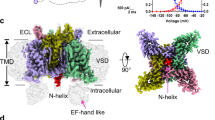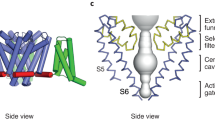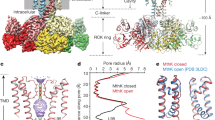Abstract
The sodium permeability in nerve is regulated by two gating processes, activation and inactivation1. Their relationship to one another has been described as ‘independent’1 or ‘coupled’2,3. An independent model, the Hodgkin and Huxley formulation, makes two testable predictions regarding gating current. First, as inactivation is voltage sensitive, it requires its own voltage sensor and might be expected to generate its own gating current. Second, gating current associated with activation should be unaffected by inactivation. Although charge movement associated with sodium activation is well characterized4, no inactivation charge movement has been described. Instead, depolarizations long enough to produce sodium current inactivation were found to diminish the charge movement associated with channel closing5. Inactivation temporarily immobilized a substantial fraction of the gating charge. These observations suit a coupled model in which inactivation gains its voltage dependence by coupling to activation3, and inactivation may in turn influence activation. However, the relative time course of the development immobilization (τimmob) was found to be the same3, the same in some voltage ranges6 and slower than that for inactivation (τinact). In crayfish axons inactivation is roughly five times faster than in squid, providing an interesting opportunity to compare inactivation and immobilization. Further, inactivation is so rapid that inactivation gating current should be easily visible. No inactivation charge movement was found and τimmob equals τinact.
This is a preview of subscription content, access via your institution
Access options
Subscribe to this journal
Receive 51 print issues and online access
$199.00 per year
only $3.90 per issue
Buy this article
- Purchase on Springer Link
- Instant access to full article PDF
Prices may be subject to local taxes which are calculated during checkout
Similar content being viewed by others
References
Hodgkin, A. L. & Huxley, A. F. J. Physiol., Land. 117, 500–544 (1952).
Goldman, L. & Schauf, C. J. gen. Physiol. 59, 659–675 (1972).
Armstrong, C. M. & Bezanilla, F. J. gen. Physiol. 70, 567–590 (1977).
Armstrong, C. M. & Gilly, W. F. J. gen. Physiol. 74, 691–711 (1979).
Bezanilla, F. & Armstrong, C. M. Cold Spring Harb. Symp. quant. Biol. 40, 297–304 (1976).
Nonner, N. J. Physiol., Lond. 299–573–603 (1980).
Meves, H. & Vogel, W. J. Physiol., Lond. 267, 377–393 (1977).
Bullock, J. O. & Schauf, C. L. J. Physiol., Lond. 286, 157–171 (1979).
Author information
Authors and Affiliations
Rights and permissions
About this article
Cite this article
Swenson, R. Gating charge immobilization and sodium current inactivation in internally perfused crayfish axons. Nature 287, 644–645 (1980). https://doi.org/10.1038/287644a0
Received:
Accepted:
Issue Date:
DOI: https://doi.org/10.1038/287644a0
Comments
By submitting a comment you agree to abide by our Terms and Community Guidelines. If you find something abusive or that does not comply with our terms or guidelines please flag it as inappropriate.



